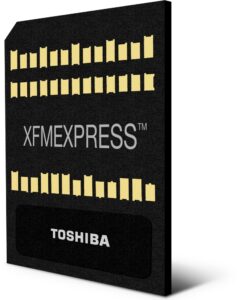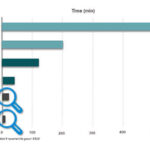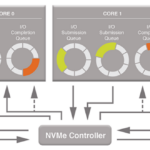 Toshiba Memory today announced XFMEXPRESS, a new technology for removable PCIe attached, NVMe memory devices. With a new form factor and an innovative connector, XFMEXPRESS technology delivers an unparalleled combination of features designed to revolutionize ultra-mobile PCs, IoT devices and various embedded applications. Recognizing the need for a new class of removable storage, Toshiba Memory leveraged its extensive background in single-package memory designs to develop XFMEXPRESS technology and offer these key features
Toshiba Memory today announced XFMEXPRESS, a new technology for removable PCIe attached, NVMe memory devices. With a new form factor and an innovative connector, XFMEXPRESS technology delivers an unparalleled combination of features designed to revolutionize ultra-mobile PCs, IoT devices and various embedded applications. Recognizing the need for a new class of removable storage, Toshiba Memory leveraged its extensive background in single-package memory designs to develop XFMEXPRESS technology and offer these key features
Putting serviceability front and center, XFMEXPRESS technology enables a new category of small memory devices and SSDs that are easy to service or upgrade. By pairing a robust, compact package with removable memory functionality and flexibility, XFMEXPRESS technology will help diminish technical barriers and design constraints.
The XFMEXPRESS form factor’s no-compromise size and low profile (14mm x 18mm x 1.4mm) offers a 252mm2 footprint, optimizing the mounting space for ultra-compact host devices without sacrificing performance or serviceability. With this minimized z-height, the XFMEXPRESS form factor is excellent for thin and light notebooks and creates new design possibilities for next-generation applications and systems.
Designed for speed, XFMEXPRESS technology implements a PCIe 3.0, NVMe 1.3 interface with 4 lanes (4L), supporting theoretical bandwidth up to 4 gigabytes per second (GB/s) in each direction, and up to 8GB/s in each direction for next-generation use cases. XFMEXPRESS technology’s industry-leading performance capabilities and durable form factor provide a compelling alternative to the status quo, enabling superior computing and entertainment experiences.
XFMEXPRESS technology offers the necessary flexibility and scalability to stand the test of time. It is both PCIe 3.0 and 4.0 capable, can be configured with 2L to 4L, and is designed to deploy current and future 3D flash memory sizes, ensuring products using the XFMEXPRESS form factor can scale with the market.
The unique design of XFMEXPRESS technology offers optimized functionality and robustness, as well as a purpose-built connector that improves ease-of-use and thermal efficiency.


Leave a Reply